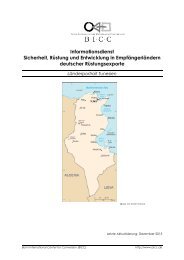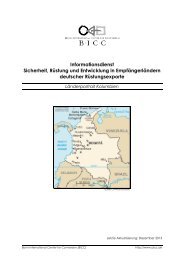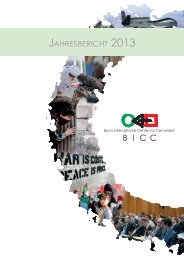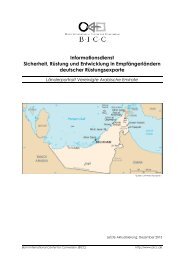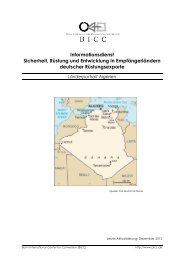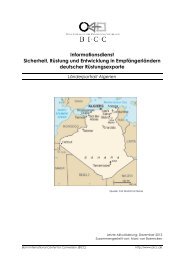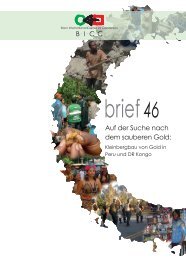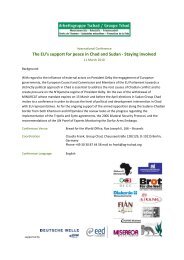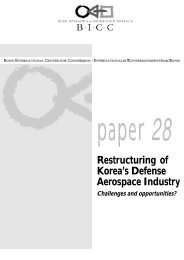English - BICC
English - BICC
English - BICC
Create successful ePaper yourself
Turn your PDF publications into a flip-book with our unique Google optimized e-Paper software.
assessments are certainly encouraging,<br />
critical views, such as those frequently<br />
expressed in the non-partisan<br />
Northern Irish left-liberal magazine<br />
Fortnight, cannot be omitted.<br />
According to an editorial of the<br />
magazine published in the summer of<br />
1998,“the institutionalized sectarianism<br />
of the Assembly will make permanent<br />
the catholic/nationalist versus<br />
protestant/unionist paradigm”<br />
(Fortnight, Editorial, 372, July-August<br />
1998, p.5.)<br />
One may assume that the<br />
consociational structure of the<br />
agreement, which has shown a<br />
tendency to cement sectarianism, was<br />
adopted regardless of the<br />
decommissioning and security issues<br />
that engendered the establishment of<br />
the twin track solution. The powersharing<br />
model seems to have been the<br />
only real governmental option since<br />
1973. We want to limit, however, our<br />
observations and findings to the<br />
impact the ambiguities of the Agreement<br />
had on security related issues. In<br />
this context, we will touch on the rarely<br />
discussed problem of the prevailing<br />
partisan approach towards<br />
decommissioning, and thereafter assess<br />
the attempts to develop a package deal<br />
during the implementation process by<br />
linking other disputed matters of<br />
security, such as demilitarisation and<br />
police reform, with the sensitive issue<br />
of decommissioning.<br />
Double standards<br />
and hypocrisy: the<br />
partisan approach<br />
towards<br />
decommissioning<br />
Unlike other post-conflict<br />
governments, such as those in Lebanon<br />
or South Africa, the power-sharing<br />
executive in Belfast was not conceived<br />
to be a government of reconciliation<br />
or of social transformation. Instead, a<br />
far more pragmatic approach was<br />
employed, which simply aimed to<br />
assemble all relevant political actors<br />
around the governmental table; this is a<br />
more imposing task than it sounds for<br />
many of these individuals had never<br />
really talked face-to-face until their first<br />
day in office. Security issues were not<br />
to be dealt with around this table as<br />
responsibility for such matters rested<br />
with the British authorities. The twin<br />
track approach helped to circumvent<br />
the establishment of mechanisms to<br />
deal with the problem posed by the<br />
continued availability of arms among<br />
the conflicting parties in the province.<br />
The matter of ending the war by<br />
abandoning the tools of violence<br />
remained the exclusive domain of<br />
British security forces and the IRA,<br />
despite an intensification of violence,<br />
predominantly carried out by<br />
disillusioned Loyalists. The difficult<br />
and sensitive process of restructuring<br />
the state’s monopoly of power in post-<br />
Agreement Northern Ireland included<br />
disarmament of paramilitary<br />
organisations (with a focus on the<br />
illegally held weapons), downsizing of<br />
state forces, and the reform of police<br />
and justice. The fact that the new<br />
power-sharing government had<br />
legitimate stakes but no authorised<br />
responsibilities in this process,<br />
prepared the ground for hypocrisy of<br />
all kinds and permitted the emergence<br />
of biased approaches and double<br />
standards, especially in the<br />
controversial field of decommissioning<br />
Most players, during negotiations and<br />
the post-Agreement implementation<br />
phase, focused on the<br />
decommissioning of IRA weapons<br />
when considering disarmament—a<br />
rather narrow interpretation of the<br />
provisions on decommissioning within<br />
the Good Friday Agreement. This<br />
tendency was also reflected in public<br />
opinion, which could be discerned in<br />
the innumerable newspaper articles<br />
written on the issue between April<br />
1998 and December 2001; over 90<br />
percent of these articles referred to<br />
decommissioning as a requirement for<br />
B·I·C·C<br />
‘‘fudging’’ the arms<br />
Republicans. There were, of course,<br />
reasons behind this imbalance. “The<br />
significance of decommissioning lay in<br />
that it was made the touchstone for<br />
placating the unionist community<br />
throughout the peace process” (Schulze<br />
and Smith, 2000, p.81). The<br />
Unionist position of not joining a<br />
government with a party linked to a<br />
private army, and the state’s threat<br />
perception, shaped by the quantity and<br />
quality of the IRA arsenal (see Box D),<br />
may have justified the establishment of<br />
this one-sided approach towards<br />
decommissioning, but was it a<br />
politically wise strategy considering<br />
that the removal of all paramilitary<br />
weapons was the final goal? “Threats<br />
to the peace process have come mainly<br />
from dissident groups such as the Real<br />
IRA, the Continuity IRA, the Loyalist<br />
Volunteer Force, and the Red Hand<br />
Defenders, which have no political<br />
representatives, are not parties to the<br />
Good Friday Agreement, and therefore<br />
would not be subject to the unionist<br />
requirement of decommissioning”<br />
(Stevenson, 2000, p.15).<br />
One may argue that the limitation of<br />
the decommissioning demand to those<br />
groups with political representation<br />
reduced the credibility of the issue as a<br />
whole, and in the same vein<br />
represented a subtle admission that<br />
neither of the two major Unionist<br />
parties felt they possessed the<br />
necessary clout and support to “use<br />
any influence they may have, to achieve<br />
the decommissioning of all<br />
paramilitary arms”, as stipulated in the<br />
decommissioning paragraph of the<br />
Agreement. This unbalanced and<br />
“partisan” approach to disarmament<br />
limited the potential of cross<br />
community conflict resolution initiatives,<br />
such as addressing the removal of<br />
the tools of violence on both sides, as<br />
an adequate response to ongoing<br />
violence. The strategy developed its<br />
own momentum, fostering<br />
accommodation in the sectarian<br />
trenches and re-invigorating the<br />
fundamental complexities of the<br />
specific Northern Irish conflict<br />
55



